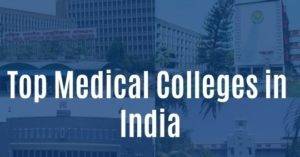Here is information about some of the top medical colleges in India:
- All India Institute of Medical Science (AIIMS), Delhi: AIIMS, Delhi is established as an institution of national importance with the aim of developing high standards of medical education in India. It offers undergraduate and postgraduate medical education across various branches.
- Christian Medical College (CMC), Vellore: CMC Vellore, founded in the 1900s, is known for its commitment to excellence and low fees. Community Medicine is given major importance, with students required to serve in healthcare facilities after graduation.
- Armed Forces Medical College (AFMC): AFMC, established in 1948, is among the premier medical colleges in India. It educates students who go on to become professionals in the armed forces.
- Jawaharlal Institute of Post Graduate Medical Education and Research (JIPMER): JIPMER is one of the top medical schools in India, located in Puducherry. It provides both medical education and low-cost medical care to patients.
- Government General Hospital: This institution, established in 1664, is one of the oldest medical institutes in India. It later became the Madras Medical College and is affiliated with the University of Madras.
- Grant Medical College: Grant Medical College, affiliated with the Maharashtra University of Health Sciences, is one of the premier medical schools in India. It accepts a large number of students for undergraduate and postgraduate courses.
- Maulana Azad Medical College: Named after Maulana Abul Kalam Azad, this college has a historic campus and has trained thousands of medical graduates since its inauguration in 1961.
- King Edward Memorial Hospital and Seth Gordhandas Sunderdas Medical College: Established in 1925, this institution prioritizes medical relief, education, and research. It is affiliated with the University of Bombay.
- Kasturba Medical College (KMC), Manipal: KMC, established in 1953, is one of the top five medical colleges in India. It offers a comprehensive medical education program and is recognized worldwide.
- University College of Medical Sciences (UCMS): UCMS, a constituent college of the University of Delhi, was founded in 1971 to provide medical education to students in New Delhi. It operates as a teaching hospital in Dilshad Garden.
- BJ Medical College: Established in 1871, this college offers postgraduate and super specialty courses in various branches of medicine and surgery. It is one of the premier institutes in India.
- King George Medical College, Lucknow: Founded in 1911, this college has been a leader in medical education in India. It is now part of the Chhatrapati Shahuji Maharaj Medical University.
These colleges are renowned for their contributions to medical education and healthcare in India.
